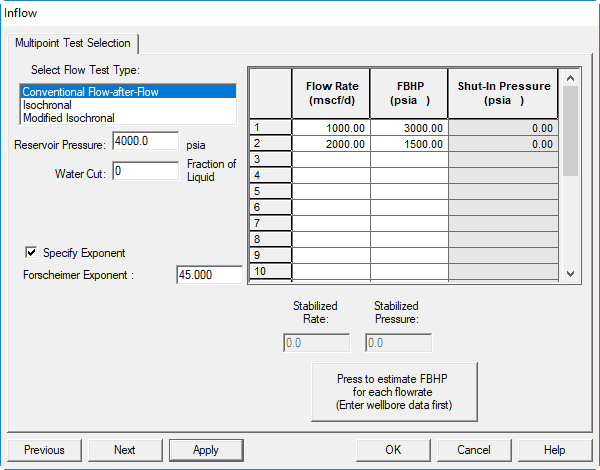|
<< Click to Display Table of Contents >> Multi-point Flow Test |
  
|
|
<< Click to Display Table of Contents >> Multi-point Flow Test |
  
|
Multi-Point Flow Test
The IPR is generated by fitting the data from a multi-point test (i.e., deliverability test), to a quadratic equation. The test procedure can be of the conventional, isochronal or modified isochronal type. Note that the MULTI-POINT FLOW TEST option, which uses measured flowing bottomhole pressure in constructing the IPR curve, does not allow you to separately calculate the pressure drop across the completion since it is implicitly included in the pressures measured downstream from the completion.
The data required is described in MULTIPOINT TEST DATA
.
When the Non-darcy exponent is defined specifically, check the box that allows that value to be entered, instead of calculated.

TEST TYPE: Displays a list of multipoint tests. Select a test type. enter the reservoir pressure, and click OK. SNAP displays a test specific data.
RESERVOIR PRESSURE (psia): The average reservoir pressure in the well's drainage area and can be obtained from pressure buildup analysis. This option is limited to one reservoir pressure for all zones.
WATER CUT (frac): The fraction of the total liquid flow stream that is made up of water. In the results, fluid rate data is reported as TOTAL fluid which includes this water cut fraction.
CONVENTIONAL FLOW AFTER FLOW TEST : This test consists of flowing the well at two or more flow rates and allowing the well to reach stabilization at every rate. The data required include the reservoir pressure, the stabilized rate, and the bottomhole pressure for each flow period.
ISOCHRONAL TEST : This test consists of two or more (usually four) flow periods with different flow rates but of equal duration. Each flow period is followed by an extended shut-in to approach average reservoir pressure. The final rate is extended to reach stabilized conditions.
MODIFIED ISOCHRONAL TEST : This test consists of two or more (usually four) sequences of flow and shut-in periods of equal duration. These are followed or preceded by an extended flow and shut-in period to obtain, respectively, a stabilized flowing pressure and the reservoir pressure.